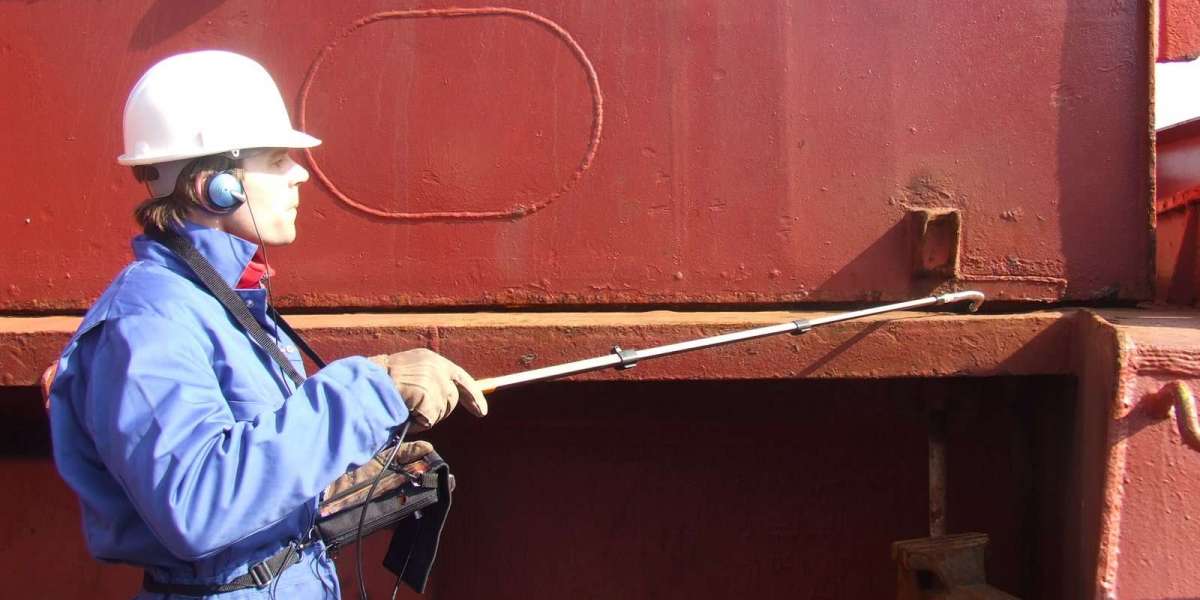Cargo vessels operate in unpredictable and often harsh marine environments, where hatch covers serve as the primary defence against water ingress. Even minor defects in these covers can lead to costly cargo damage and operational disruptions. Routine testing and maintenance are crucial to ensuring the continued efficiency of hatch covers. Ultrasonic hatch cover tightness testing has emerged as a reliable, non-intrusive solution to detect leaks early. This article highlights the benefits of ultrasonic testing, the role of ultrasonic hatch cover testers, and the importance of regular maintenance of hatch covers.
Why Hatch Cover Tightness is Vital
Ensuring the tightness of hatch covers is critical to protect cargo and ensure vessel stability. Water ingress through even small gaps can compromise the quality of goods, result in insurance claims, and cause delays. In severe cases, excess water in the cargo holds can affect the stability of the vessel, putting both the crew and cargo at risk.
While traditional testing methods, such as hose water tests, have long been used, they come with limitations. They are time-consuming, require favourable weather, and can introduce unnecessary moisture into the cargo holds. Ultrasonic hatch cover tightness testing offers a faster, more accurate alternative.
How Ultrasonic Hatch Cover Tightness Testing Works
Ultrasonic testing uses high-frequency sound waves to detect leaks without the need for water. The process is simple yet highly effective:
- Ultrasonic transmitter: Placed inside the cargo hold, it emits ultrasonic sound waves.
- Ultrasonic receiver: An inspector uses the receiver on the outside of the hatch cover to detect escaping sound waves.
- Leak detection: If ultrasonic waves pass through any gap in the cover’s seal, the receiver picks them up, indicating a potential leak.
This technology enables operators to identify even the smallest leaks before they cause significant damage, ensuring the cargo remains protected throughout the voyage.
The Benefits of Using Ultrasonic Hatch Cover Testers
Ultrasonic hatch cover testers are essential tools for ship operators and surveyors, providing quick, accurate assessments of hatch cover integrity. Cygnus Instruments, a trusted leader in ultrasonic technology, offers testers designed specifically for maritime applications.
Key advantages of ultrasonic hatch cover testers
- High accuracy: Detects even micro-leaks that may go unnoticed with traditional methods.
- Speed: Quick testing reduces downtime during port operations.
- Non-invasive: No water is required, preventing moisture from entering the cargo hold.
- Cost-effective: Early detection helps avoid costly repairs and cargo losses.
- User-friendly: Lightweight and easy to operate, allowing for seamless inspections.
With ultrasonic hatch cover testers from Cygnus Instruments, operators can ensure their vessels remain safe, operational, and compliant with international maritime standards.
Routine Maintenance of Hatch Covers: A Key Component
While ultrasonic testing is crucial, regular maintenance of hatch covers is essential to extend their lifespan and ensure reliable performance. A proactive approach to maintenance helps minimise the risks of unexpected failures and reduces repair costs over time.
Essential maintenance practices for hatch covers
- Visual inspections: Regularly check for signs of corrosion, cracks, and damage.
- Seal checks: Monitor seals for stiffness, wear, or cracks and replace them promptly.
- Cleaning and drainage: Ensure drainage channels are clear to prevent water accumulation and corrosion.
- Lubrication: Apply lubricants to hinges and other moving parts to prevent mechanical issues.
- Scheduled ultrasonic testing: Conduct ultrasonic tests at regular intervals to identify leaks early.
Implementing these maintenance practices helps ensure that hatch covers perform efficiently throughout every voyage, safeguarding cargo and preventing costly disruptions.
How Cygnus Instruments Supports the Maritime Industry
Cygnus Instruments is renowned for its innovative ultrasonic solutions tailored for maritime needs. Their ultrasonic hatch cover testers are designed to withstand the demanding conditions of shipping operations, offering accurate results and easy operation.
Cygnus Instruments’ products align with international safety standards, providing ship operators with the confidence that their vessels meet industry requirements. These advanced tools empower maritime professionals to detect leaks early and maintain cargo safety efficiently.
The Superiority of Ultrasonic Testing Over Traditional Methods
Traditional testing methods, such as hose water tests, present several drawbacks:
- Weather dependency: They require dry conditions, causing delays if weather is unfavourable.
- Labour-intensive: Hose tests demand more time and manpower.
- Water usage: Introducing water during testing increases the risk of moisture in cargo holds.
Ultrasonic hatch cover tightness testing offers clear advantages:
- All-weather capability: Tests can be conducted in any weather condition.
- Immediate feedback: Results are available instantly, enabling quick decision-making.
- Non-intrusive: No water is needed, ensuring the cargo remains dry.
- Fast and efficient: Testing takes less time, minimising operational downtime.
With its precision, speed, and convenience, ultrasonic testing has become the preferred choice for modern shipping operators.
Conclusion: Proactive Care for Safer Voyages
The integrity of hatch covers plays a crucial role in ensuring cargo safety, vessel stability, and operational efficiency. Ultrasonic hatch cover tightness testing offers ship operators a fast and accurate way to detect leaks early, reducing the risk of cargo damage and costly repairs.
By using ultrasonic hatch cover testers from trusted manufacturers like Cygnus Instruments, operators can ensure their vessels meet the highest safety standards. These devices provide immediate, reliable results, helping operators maintain smooth operations and compliance with maritime regulations.
However, testing alone is not enough. A proactive maintenance plan is essential to keep hatch covers in optimal condition. By combining regular inspections, timely repairs, and ultrasonic testing, ship operators can safeguard cargo, optimise operations, and minimise risks throughout every voyage.
In the competitive world of maritime shipping, investing in ultrasonic testing and consistent maintenance is essential for long-term success and peace of mind.








